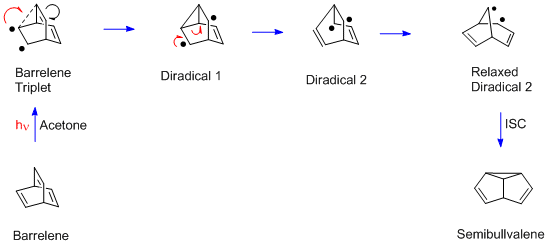齊默爾曼重排反應
齊默爾曼重排反應(Zimmermann rearrangement),亦稱二-π-甲烷重排反應(Di-pi-methane rearrangement),指1,4-二烯光促轉化為烯基環丙烷的反應。[1]它是一種光化學反應,在光反應條件(hv)下發生於含有兩個π電子體系且被一個飽和碳原子分開的分子實體中(通常為1,4-二烯或烯丙基芳環),產物為烯基或芳基取代的環丙烷。該重排相當於二烯中的一個烯基或芳基發生了1,2-遷移,並在未遷移部分的兩個不動的碳原子間形成了一根σ共價鍵。[2][3]

發現及機理[編輯]
該重排反應最早在桶烯光解得到半瞬烯的反應中被觀測。[4] 1967年反應機理被霍華德·齊默爾曼表徵。由於清晰地了解到該反應的結構要求(一個sp3雜化的碳原子上連接有兩個π體系),其後一段時間有更多的反應實例被研究者們獲得。其中一個典例是Mariano二烯(3,3-二甲基-1,1,5,5-四苯基-1,4-戊二烯)的光解反應。[5][6][7] 另一個典例是關於Pratt二烯的反應。 [8]

不同的是,在Pratt二烯重排中存在兩種可能的區域選擇性,圖示路徑a為優勢反應,因為單電子在苯基的共軛作用下更加穩定。

桶烯的重排機理業已提出,由於桶烯中存在兩個sp3雜化的橋頭碳原子,且每個橋頭碳連接有3個π體系(乙烯類),其中兩個用於齊默爾曼重排,故該機理較以上兩個例子更顯複雜。另外,桶烯處於三重態,而Mariano二烯和Pratt二烯的處於單重態,故桶烯重排用丙酮作為光捕捉和傳遞劑(促使反應發生)。重排最後一步發生了系際交叉躍遷(ISC)以將單電子翻轉至合理狀態來形成一個新的σ鍵。

齊默爾曼重排反應的成功取決於三重態和單重態間主要展現的自由旋轉效應(Free-Rotor Effect)。[9]
齊默爾曼重排反應禁阻的三重態無環1,4-二烯可以經雙鍵的順反異構化,即通過扭曲減弱π鍵,而轉變為允許發生反應的單重態(不旋轉)。對環狀1,4-二烯而言,如上述桶烯,環結構阻止了順反異構化,故發生齊默爾曼重排需要額外的光捕捉和傳遞劑(丙酮)。
參見[編輯]
參考文獻[編輯]
- ^ Jie Jack Li. Name Reactions Fifth Edition. Springer. 2014-09-30: 654~655. ISBN 978-3-319-03978-7.
- ^ 國際純化學和應用化學聯合會,化學術語概略,第二版。(金皮書)(1997)。在線校正版: (2006–) "di-π-methane rearrangement"。doi:10.1351/goldbook.D01745
- ^ Zimmerman, Howard E.; Armesto, Diego. Synthetic Aspects of the Di-π-methane Rearrangement. Chemical Reviews. 1996, 96 (8): 3065–3112. PMID 11848853. doi:10.1021/cr910109c.
- ^ Zimmerman, H. E.; Grunewald, G. L. The Chemistry of Barrelene. III. A Unique Photoisomerization to Semibullvalene. J. Am. Chem. Soc. 1966, 88 (1): 183–184. doi:10.1021/ja00953a045.
- ^ Zimmerman, Howard E.; Binkley, Roger W.; Givens, Richard S.; Sherwin, Maynard A. Mechanistic organic photochemistry. XXIV. The mechanism of the conversion of barrelene to semibullvalene. A general photochemical process. Journal of the American Chemical Society. 1967, 89 (15): 3932–3933. ISSN 0002-7863. doi:10.1021/ja00991a064.
- ^ Zimmerman, H. E.; Mariano, P. S. The Di-pi-Methane Rearrangement. Interaction of Electronically Excited Vinyl Chromophores. J. Am. Chem. Soc. 1969, 91: 1718–1727. doi:10.1021/ja01035a021.
- ^ Hixson, Stephen S.; Mariano, Patrick S.; Zimmerman, Howard E. Di-pi-methane and oxa-di-pi-methane rearrangements. Chemical Reviews. 1973, 73 (5): 531. doi:10.1021/cr60285a005.
- ^ Zimmerman, H. E.; Pratt, A. C. Unsymmetrical Substitution and the Direction of the Di-pi-Methane Rearrangement; Mechanistic and Exploratory Organic Photochemistry. LVI. J. Am. Chem. Soc. 1970, 92: 6259–6267. doi:10.1021/ja00724a026.
- ^ Zimmerman, H. E.; Schissel, D. N. Di-pi-Methane Rearrangement of Highly Sterically Congested Molecules; Inhibition of Free Rotor Energy Dissipation. Mechanistic and Exploratory Organic Photochemistry. J. Org. Chem. 1986, 51: 196–207. doi:10.1021/jo00352a013.
